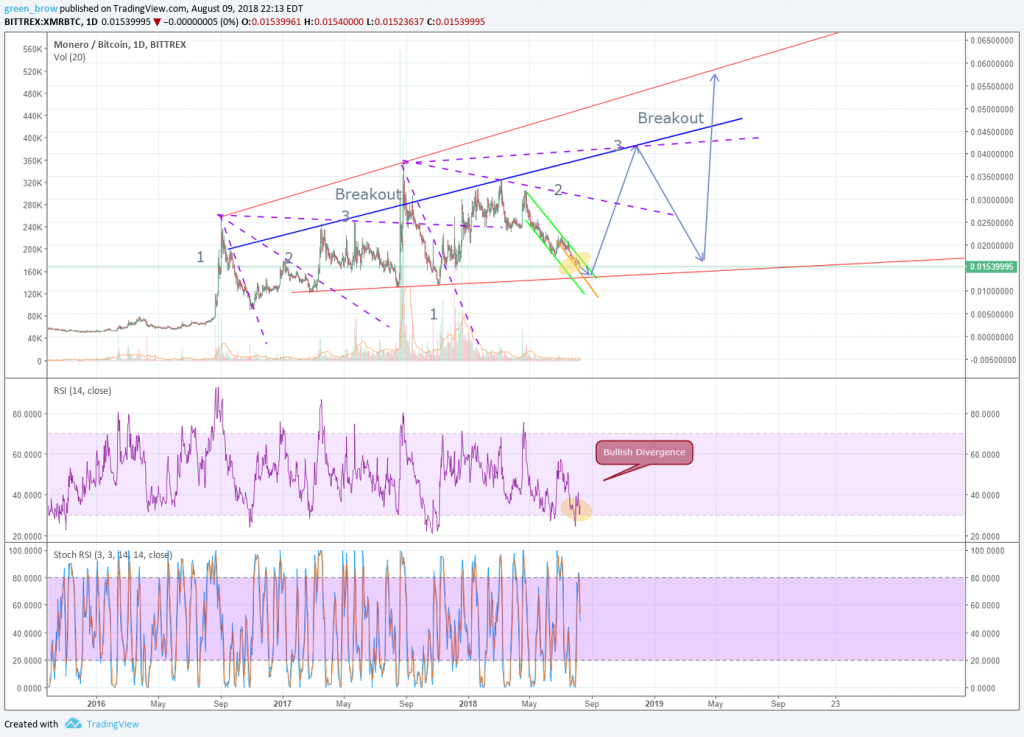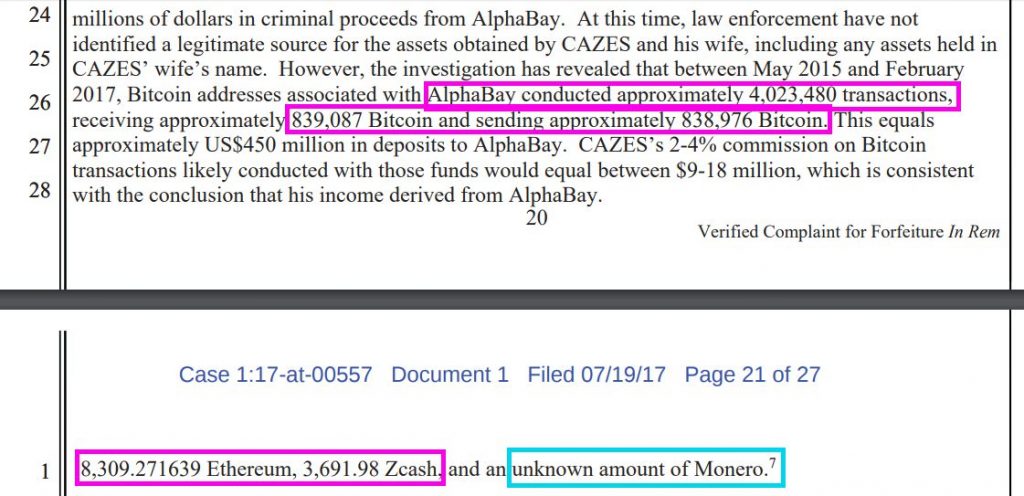The bear market has been rather brutal to every currency out there, including Monero. We saw it reach its July BTC highs around the 4th, when one Monero coin went for 0.02180130 BTC. Its USD highs came later on July 18th, when the coin was valued at 146.61 USD. Ever since, it has been a gradual bleed for Monero’s price which reached its monthly BTC lows of 0.01577590 BTC on the 31st (USD lows came about much earlier when the price broke below 120 USD on the 12th). The fall has continued in August and currently you can purchase one XMR for the price of $88.10 USD (5.66% rise in the last 24 hours)/0.01300434 BTC (0.66% rise in the last 24 hours).
Monero maintains a daily trade volume of 4,395 BTC. With a market cap of 1,431,957,361 USD, the coin is currently the 10th most valuable cryptocurrency on the market.
We turned to green_brow for today’s Monero TA:

“Monero about to touch longer term support; expect it to bounce around 0.013 BTC. Bullish divergence on the RSI as well as increasing volume agrees with this prediction. Price target is the outlined blue resistance line, corresponding to the third fan line. If it breaks this line, next target is the upper red resistance line. If it is rejected at the blue line, expect the next attempt to push through to the upper red line. These movements should also correspond nicely to Kovri updates, hopefully encouraging some price action.”
The biggest announcement regarding Monero was a recent Monerujo app update. This open source mobile app which lets users create and manage XMR wallets saw the 1.6.3 version of its protocol released just a couple of days ago. In this new update Monerujo team introduced several major changes from the previous version:
- Ledger Nano S support over OTG
- NFC Support for Receive & Send (like QR Code)
- Minor bug fixes
- New translations: Greek, Hungarian, Romanian, Russian, Swedish
- Select App Language
- Restoreheight can now be entered during Restore as YYYYMMDD as not all numeric keyboards allow hyphens
Thanks to this update, users can now create a Monero wallet on desktop GUI 0.12.3 using a Ledger Nano S and can then use the Monerujo app (with the help of a USB-OTG cable or micro-to-micro / micro-to-USB-c cable) to connect and manage said wallets via phone. Users can now basically have the security of a hardware wallet and the usability of a phone wallet at the same time. The integration was initially released with the 1.6.1 version of Monerujo but said version needed the fixes that were implemented in 1.6.3. Granted, the team developing this app admits it’s still not a fully fleshed out product (as is anything in crypto really) and are promising new updates in the future.
?What does HODL mean?
Monero has one of the more active communities in crypto, with active presence on Reddit and Bitcointalk. The biggest point of contention in the community was an article posted on Bloomberg, in which Lilita Infante of the U.S. Drug Enforcement Administration had some comments about who exactly uses cryptocurrencies nowadays. She feels a “flip” has happened, a flip that saw the percentage of people who use blockchain technology for criminal activities be reduced from 90% to about 10%.
“The volume has grown tremendously, the amount of transactions and the dollar value has grown tremendously over the years in criminal activity, but the ratio has decreased. The majority of transactions are used for price speculation.’’
But what interested the Monero community the most were her claims that the agency has ways of tracking even the privacy-focused currencies like Monero or Zcash.
“The blockchain actually gives us a lot of tools to be able to identify people. I actually want them to keep using them,” Ms. Infante boastfully concluded her interview. The community immediated dismissed her claims, with travis- from Reddit summing everyone’s thoughts nicely:
“Theres a good chance she’s never heard of Zcash or Monero and just assumes they can track blockchains.”
Seemingly the final nail to the coffin of her claims was posted a couple of days after her interview, and it perfectly detailed the government’s inability to track Monero transactions and payments.

And while most were delighted by this screenshot, fireice_uk wasn’t completely impressed by what he saw:
“Unknown amount != untrackable. They are totally different things. Add some metadata and a ring signature falls apart before your eyes.”
The scenario here, of course, being that the seller of the product which received Monero has been compromised (arrested or had his private keys confiscated). In this case, a thorough analysis of metadata could potentially result in the buyer’s identity getting exposed.
?Read our head to head comparison of crypto exchanges: Binance or Kucoin – which one is better?
Of course, this situation requires that one or both parties included in it are criminals. It’s no secret that privacy currencies do attract such people, as their features are simply too good to pass on when conducting illegal business. It’s arguable that criminals care more about internet becoming more private than the general public. Currently the issue of crime on Monero blockchain is one that is very popular in the community: A user named Vespco started this thread a couple of days ago, in which he posed an interesting question:
“I think we should regroup into a potentially sacrificial r/DarkNetMonero subreddit where we talk about using Monero for illegal purposes. This doesnt jeaprodize the main r/Monero from being shut down, nor make it associated, but it discusses real uses that will drive adoption: dark net transactions for drugs, copyright/counterfeit material, laundering, etc.”
Some people were critical of his idea, choosing to stay legal with slower adoption rather than turning to criminals for help. After all, blockchain technology was invented to escape the criminals that prop-up and populate the world’s financial ecosystem, so it wouldn’t make much sense to abandon the core principles for short-term gains (in what is widely recognized as a long-term game). Others feel that only illegal businesses currently have interest for cryptocurrency and that they can be turned into effective weapons of adoption. This partially isn’t true as businesses all over the world have shown their willingness to explore and adopt blockchain solutions. The fact that criminals could contribute to a more widespread adoption is correct, except one wonders how this look will like to the general public that should be the main adopter of the technology. You can check out the complete discussion on this topic here.
Monero remains one of the stronger privacy coins on the market, if not even the strongest one. With strong development and a fitting community support, the future seems bright.







